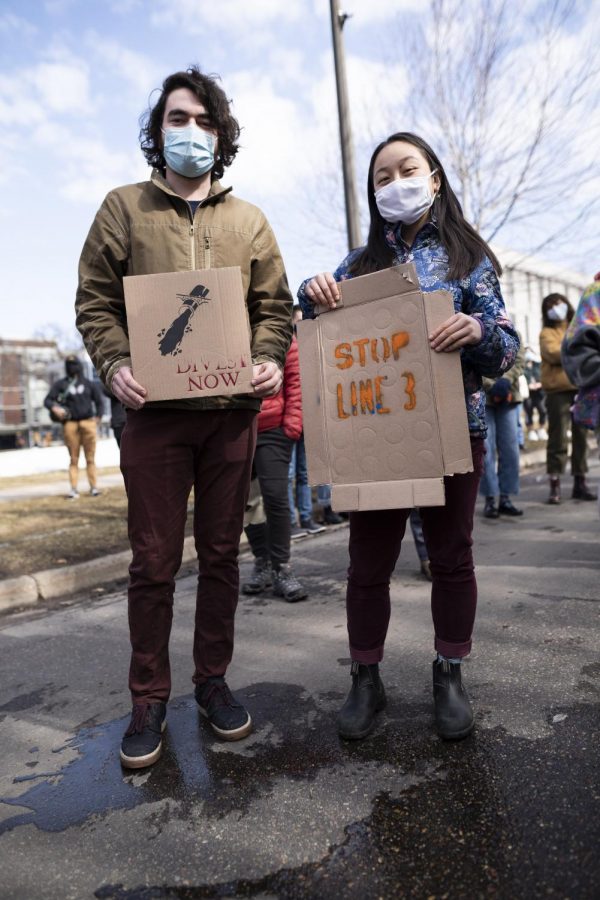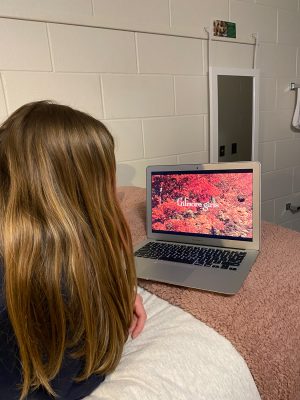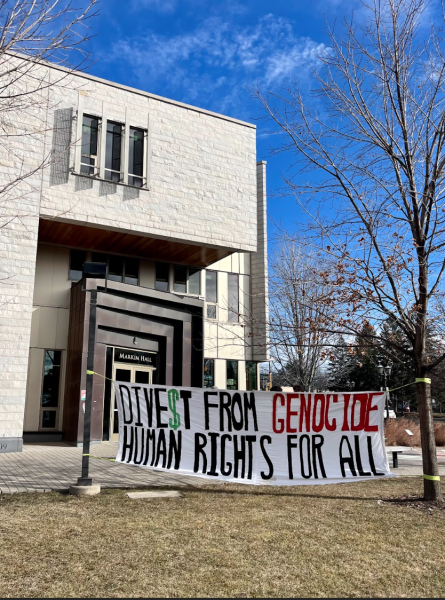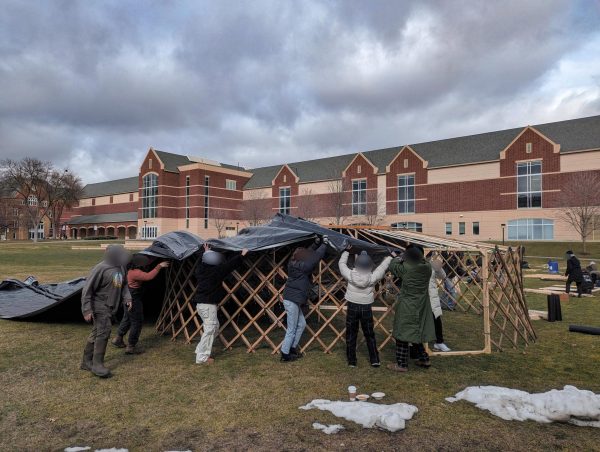Line 3 debate comes to Minn. Court of Appeals
Students pose with signs at a demonstration against Macalester’s investment in Enbridge Energy. Photo by Celia Johnson ’22.
March 25, 2021
The Minnesota Court of Appeals heard oral arguments on Tues., March 23 from activists and government officials who are attempting to halt construction on Enbridge’s Line 3 pipeline under construction in northern Minnesota.
The petitioners claim that the Minnesota Public Utilities Commission (PUC) made key legal errors, granting the Enbridge Energy Corporation a certificate of need (a construction permit) based on inadequate economic forecasts and misleading safety assessments. The respondents, representing Enbridge and the PUC, deny that the materials Enbridge provided the state are out of compliance with the law or legal standards. Petitioners urged the court to revoke the certificate of need, which would freeze construction on the pipeline.
The Line 3 pipeline is set to cross from the Canadian border into Wisconsin and transport crude oil to be sold overseas. Opponents have criticized the pipeline’s route through Indigenous treaty territories and its potential environmental impact.
The ensemble of petitioners included the Minnesota Department of Commerce, the Red Lake Band of Chippewa, the White Earth and Mille Lacs bands of Ojibwe, the Indigenous environmentalist group Honor the Earth, Friends of the Headwaters, the Sierra Club, and Youth Climate Intervenors.
Indigenous and climate justice activists trumpeted this hearing as “Line 3’s day in court.” Though several of these groups base their Line 3 opposition on Indigenous treaty rights and climate imperatives, they used the hearing to challenge the economic justification for granting the certificate of need.
To receive the certificate, Enbridge had to prove that a new pipeline was necessary infrastructure by showing that there will be a long-term demand for oil transported by the pipeline. Enbridge provided an economic forecast of how much crude oil will be produced in the next 25 years and illustrated a demand for moving oil.
Counsel for the Department of Commerce Katherine Hinderlie argued that an adequate forecast would have looked at projections of crude oil consumption.
“By looking instead at that demand to transport crude oil instead of the demand for crude oil itself, Enbridge shifts the focus of the analysis from the refineries who will consume the crude oil… to the desire of crude producers to sell and ship as much oil as they can,” Hinderlie said.
Friends of the Headwaters representative Scott Strand claimed that the PUC, which grants certificates of need, erred in accepting Enbridge’s forecast and granting the certificate.
“Supply forecasts [and] shipper support are not a proxy for demand. If there was evidence that there was going to be consumer demand that would support the necessity of this project, it would be in the record,” Strand said.
The petitioners argued that if Enbridge had forecasted crude oil demand, it could not have justified the pipeline as necessary infrastructure due to a national and global decline in fossil fuel consumption, and therefore would have failed to receive the certificate.
When the respondents took the virtual podium, they defended Enbridge’s use of crude oil transport as an indicator of necessity. Enbridge representative Christy Brusven argued that projections of oil supply are an adequate marker for pipeline necessity because producers will use Line 3 to transport their product.
“If the data that you’re looking for is ‘what is that forecast of demand?’, you’re looking for the utilization of the mainline,” she said.
PUC counsel Jason Marisam employed a textual argument, claiming that Enbridge followed the letter of the law when crafting their forecast. He explained that the PUC defined demand as “how much oil is going to come through the applicant’s facilities,” meaning that Enbridge’s forecast is legally sufficient.
“If you look at the definition of demand in the commission’s rule, what Enbridge submitted meets that definition under the best, most natural reading of that rule,” Marisam said.
He explained that the statute governing certificates of need never defines demand, and therefore it is within the PUC’s authority to decide the definition.
The petitioners also decried an Environmental Impact Statement (EIS) Enbridge produced to obtain the certificate. For its EIS, Enbridge chose to model an oil spill at Little Otter Creek in Carlton County, and their data showed that oil from a spill at Little Otter Creek would be unlikely to reach Lake Superior. Enbridge claimed that this proves the pipeline poses a negligible environmental threat to the lake. The petitioners pointed out that Little Otter Creek is not a representative site, as it is more than 30 miles away from Lake Superior in an area with slow moving currents.
“The outcome of this modeling is a foregone conclusion,” David Zoll, who represents the Mille Lacs Band of Ojibwe, said. “How can you comply with the court’s mandate to evaluate the impacts of a spill on Lake Superior if you choose a location that has a negligible possibility of a spill affecting the lake?”
Respondents argued that the EIS properly assesses the pipeline’s environmental risk to Lake Superior according to the law. Marisam noted that all the Appeals Court required was “an analysis of a spill in the Lake Superior watershed,” with no further explanation, meaning the Little Otter Creek model aligned with the legal expectations.
“[Petitioners] concede that the modeling at Little Otter Creek is helpful and useful in defining what those potential impacts are,” Brusven said.
Furthermore, the respondents explained that Little Otter Creek was selected as a representative site because its environmental characteristics and proximity to connecting rivers meant it had the most potential for a hypothetical spill to reach Lake Superior. They claimed that the petitioners failed to prove that the location or methodology used for the EIS was inadequate according to the law.
The Court has 90 days to issue a ruling, meaning a decision could be released on June 21 at the latest. If the certificate of need is revoked, construction on Line 3 would be halted until Enbridge reapplied according to the Court’s instructions, which might include a directive to produce a revised economic forecast or EIS. If the certificate is upheld, pipeline construction would continue as planned.
Listen to a full recording of the oral arguments here.













